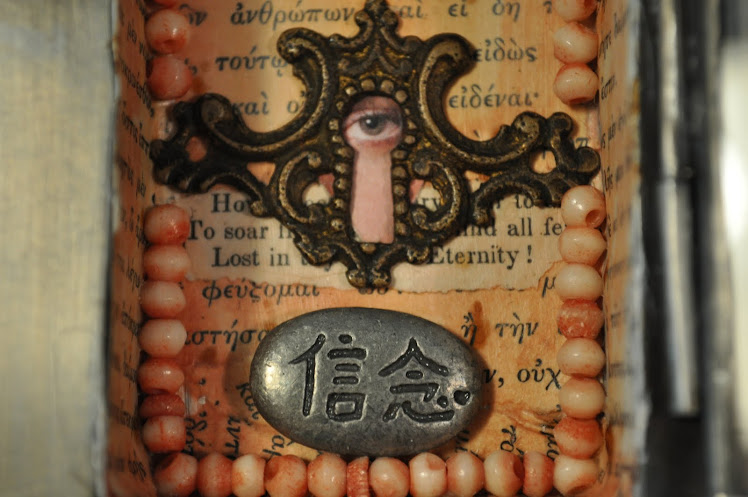There is a wonderful sense of iconoclastic glee that comes over me when I alter a book. At first, I was very hesitant to work with books – even opening a book wide enough to break the “spine” was difficult. Books have always been a major part of my life – from reading Nancy Drew under the covers with a flashlight as a child to making my own hardbound books as journals. I love books, and along with my husband have a large library which I would never dream of “altering”. My first altered book was an ancient book of poems which was already falling apart. The pages crumbled nicely to the touch. The first rip of papers that I made out of this book made me cringe, but before long I was ripping, gluing, nailing and wrapping. I became an ardent book alterer! The creative possibilities were and are endless, and open for exploration. Books become “reliquaries” for ideas, thoughts and aspirations. They become a place to tell a story of my own. Books are linked to ideas, language, and communication, and the visceral sense of touching, smelling and opening a book cannot be replicated by “Kindle”.
Working on and with books I like to describe a narrative of sorts – one that the viewer has to complete in the spaces between imagination and cognition. The altered books remain a way to work within the confines of the rectangle while re-imagining a small world. I use a juxtaposition of images from classical art, personal mementos and magazines, containing both secular and religious connotations. Cutting into the front of the book and adding Mexican “nichos” creates a place to add objects – jewels, pearls and talismans.
The collages are similar to the altered books, in that they form a visual narrative, but within a two dimensional space. The addition of stitching using waxed linen thread sometimes becomes the “thread of thought” which holds the visual narrative together. By bisecting images with thread I like to encourage the viewer to look into the spaces in between the images, and contemplate the world that lies there. The books and collages traverse written word, images, printmaking and painting.
Paper is an important part of my work, and some of my paper is hand made in my kitchen, using a blender, white glue for sizing, a screen for drying and left over scraps of thick, luscious printmaking paper. Other papers are from India, Thailand, Italy, Japan and China. Some of the work is covered with a “wallpaper” of text from books – I find that there is nothing more visceral and nostalgic as the natural yellowing of the papers of an old book! I then apply collaging materials such as photos, words, and found objects. These are glued onto my collage backing, or into an altered book using stiff gel medium. Then water-based mediums – acrylics, gouache, watercolor and sometimes gesso is added, and linen thread sewn into the image. The linen thread is made especially for bookbinding – one runs the thread over a block of beeswax to make it sew through paper more easily. There are snippets of text from the poems of Lord Byron, Spencer’s Faerie Queene, and Plato’s re-telling of Socrates’ Apology. The viewer is given scraps of information, but the completion of the idea must be realized individually. The viewer is drawn into every quadrant of the image, at times needing a magnifying glass to “translate” the image or text. Some of the books can be opened and blank sheets of paper are incorporated to create a sketchbook or journal for the owner. Some of the books are meticulously glued open, and the open, embracing space becomes a place to create a diptych.
